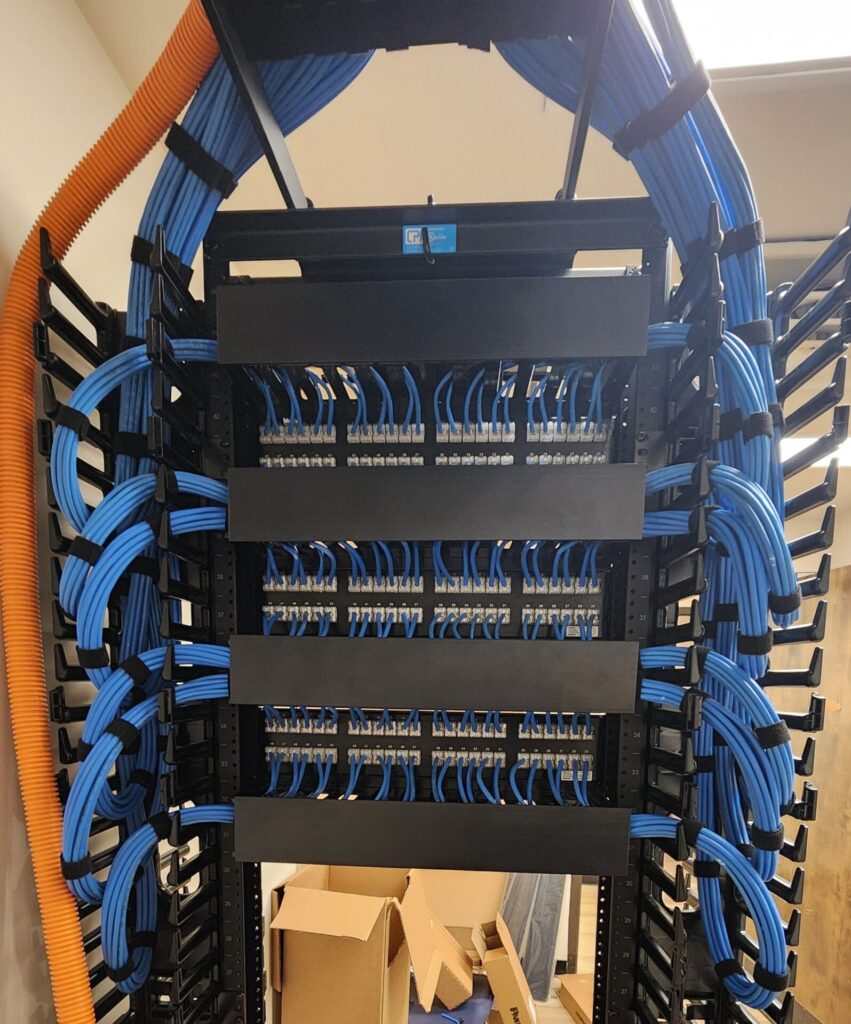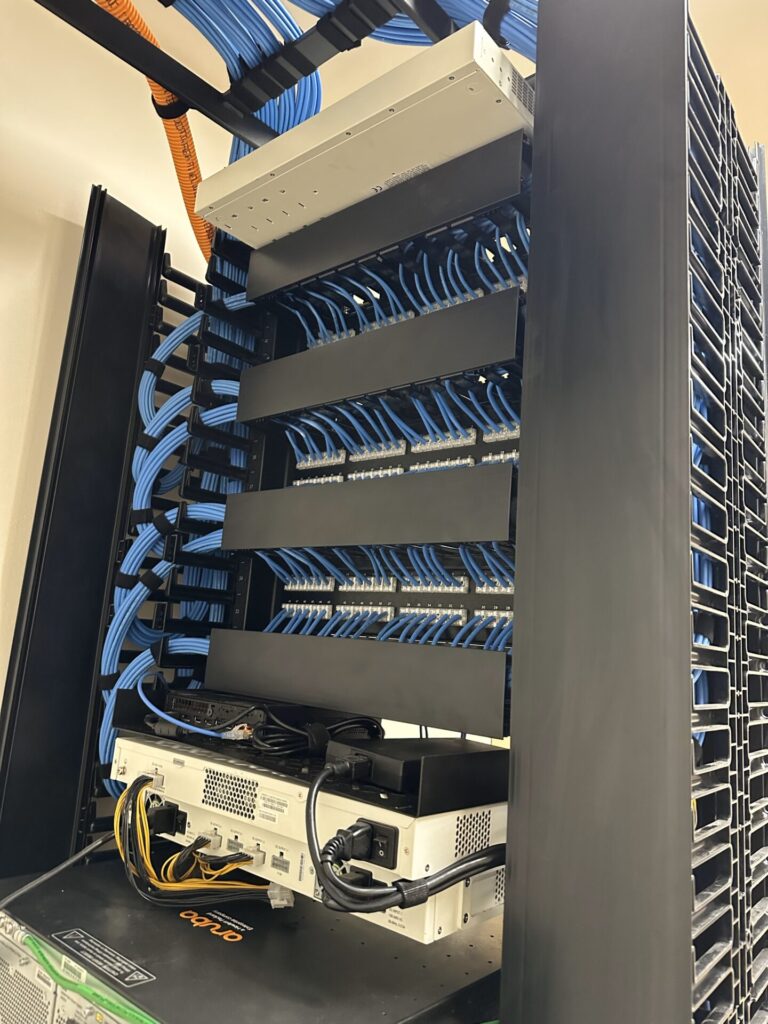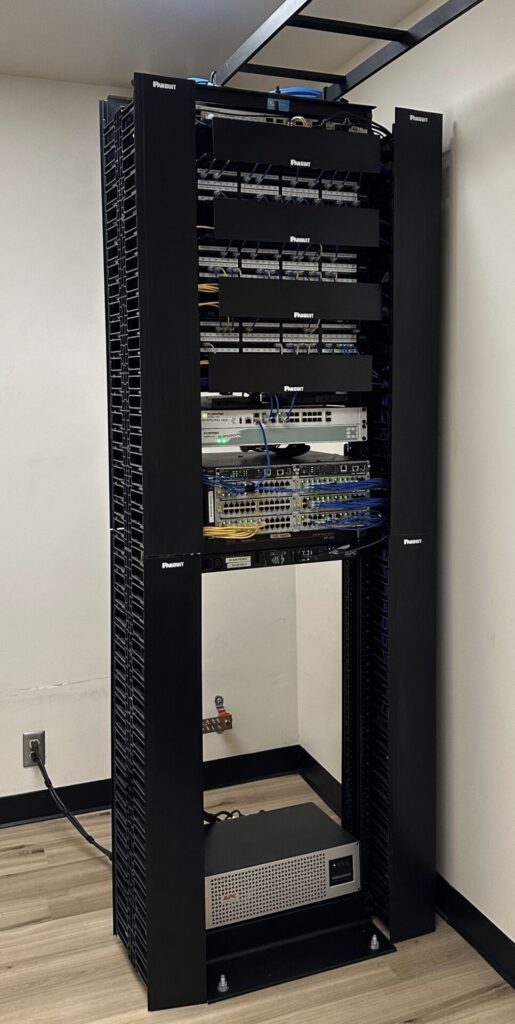Data Center Cleanup
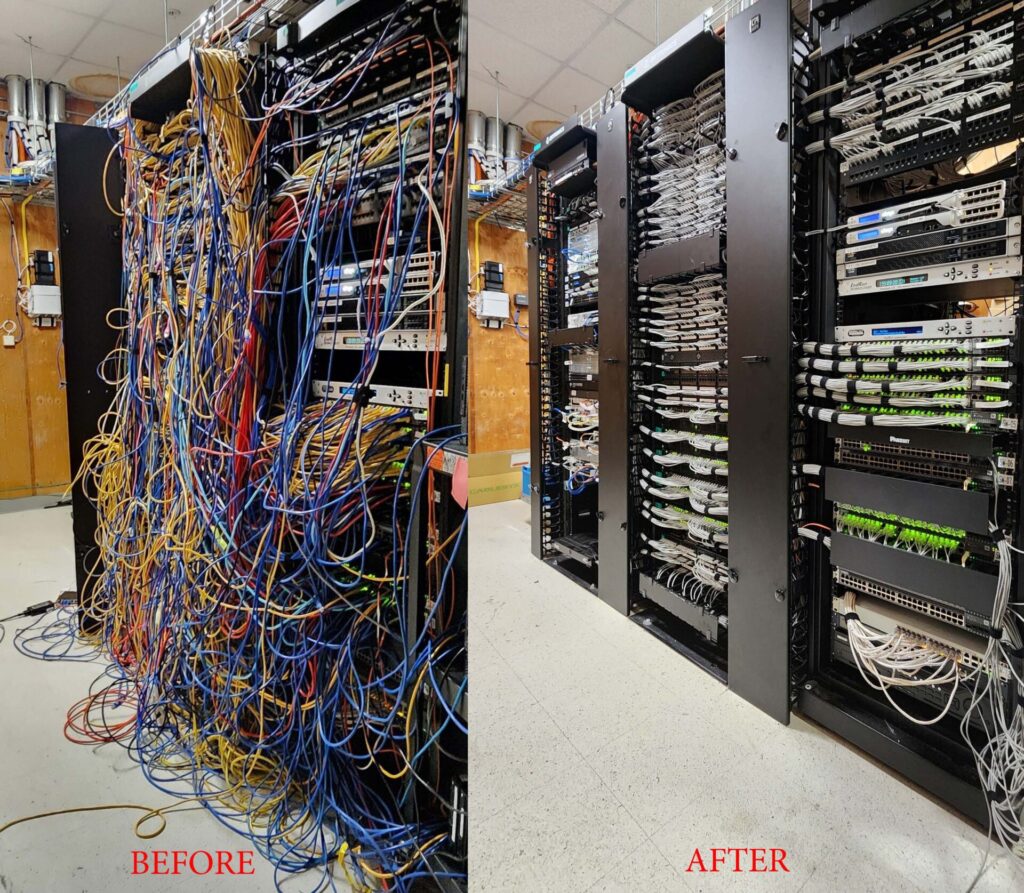
One of the many services that CableMasters provides is Data Center Cleanups. Yes, these are the same network racks. The left image is highly disorganized, making it difficult to manage or troubleshoot. The right image is after the cables were neatly arranged, labeled, and documented for the client which improves the network’s performance, reliability, and maintainability. Obviously this is more efficient but it also provides better airflow (leading to improved cooling), and a lower risk of accidental disconnections or damage.
A network rack can become disorganized and chaotic, as seen in the “before” picture, for several reasons:
- Ad-hoc Additions: Over time, equipment may be added or replaced without a structured plan. When devices are added hastily, cables are often run in the easiest or quickest way possible, leading to tangles and disarray.
- Lack of Cable Management: Without a proper cable management system (such as cable trays, ducts, or ties), cables can quickly become tangled and messy. Neglecting to label cables also contributes to confusion and disorder.
- Limited Time and Resources: IT staff may be under pressure to perform installations and maintenance quickly, prioritizing speed over organization. Immediate needs often take precedence over long-term planning and tidiness.
- Inexperienced Technicians: Technicians or engineers who lack experience or training in proper cable management may not follow best practices, leading to poor cable routing and organization.
- Changes and Upgrades: Frequent changes, such as upgrades, adding new servers, or reconfiguring networks, can contribute to the mess. If cables are not removed or rerouted properly during these changes, the tangle worsens.
- Neglect and Procrastination: Sometimes, the mess is simply due to neglect. Cleaning up and organizing a network rack can be a daunting task, leading to procrastination and further accumulation of disorganization.
- Poor Initial Setup: If the initial setup of the network rack was not done with proper planning and consideration for future growth, it can lead to a disorganized mess as more cables and devices are added over time.
To prevent such disorganization, it is important to follow best practices for cable management, such as:
- Planning the layout and future expansion from the beginning.
- Using labeled cables and color-coded systems for easy identification.
- Implementing proper cable management tools like trays, Velcro ties, and cable ducts.
- Regularly reviewing and maintaining the rack to ensure it stays organized.
- Training staff on the importance of maintaining an organized network rack.
By adhering to these practices, a network rack can remain organized and functional, preventing the chaos seen in the “before” picture.
Sumitomo FutureFLEX Air-Blown
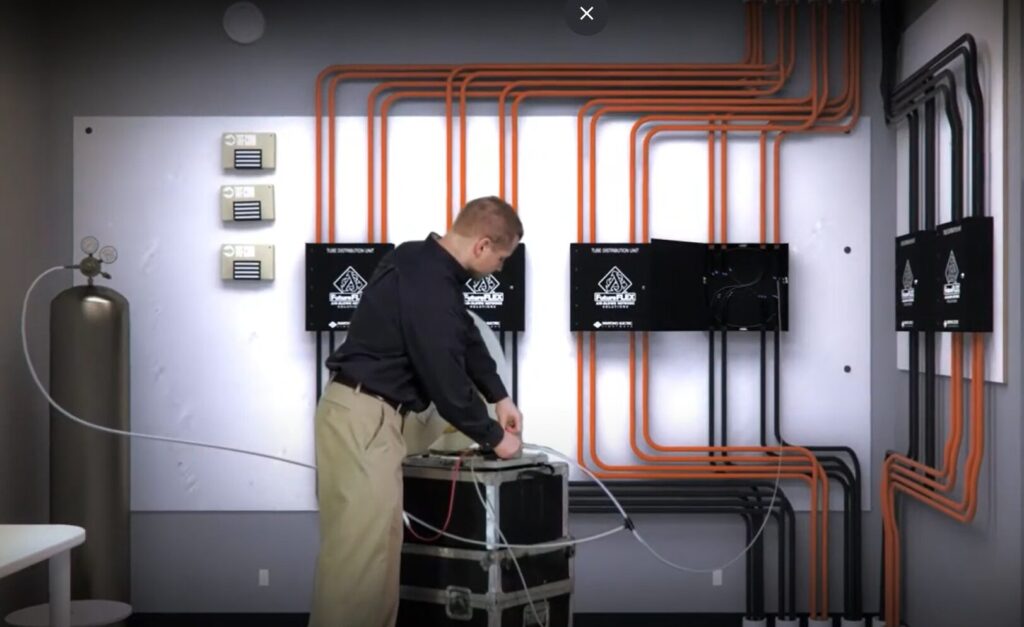
Another service that CableMasters provides is Sumitomo FutureFLEX Air-Blown Fiber (ABF)
Sumitomo FutureFLEX Air-Blown Fiber (ABF) is an innovative fiber optic cabling system designed for flexible, scalable, and efficient network infrastructure deployment. Here’s a summary of its key features and benefits:
Key Features:
- Air-Blown Installation: Fiber optic cables are blown through a network of pre-installed tubes using compressed air. This method allows for easy and rapid installation and reconfiguration.
- Modular Design: The system uses a network of tubes (microducts) which can be installed in advance. Fiber cables are blown into these tubes as needed, making it highly adaptable to changing network requirements.
- Scalability: Additional fibers can be installed without significant disruption to existing infrastructure, allowing for future expansion without the need for major construction.
- Efficiency: Reduces the need for initial over-provisioning of fiber cables. Only the required amount of fiber is installed initially, reducing waste and cost.
- Reduced Downtime: Simplifies upgrades and maintenance, minimizing network downtime since new fibers can be added or replaced without disturbing the existing network.
- Flexibility: Ideal for environments where network demands change frequently, such as data centers, campuses, and metropolitan areas.
Benefits:
- Cost-Effective: Lower initial investment due to reduced need for over-provisioning. Future upgrades and expansions are also more economical.
- Quick Installation: Faster deployment compared to traditional fiber installation methods. The air-blown method allows fibers to be installed quickly and efficiently.
- Adaptability: Easily accommodates network changes and expansions. Fibers can be added, removed, or replaced as network needs evolve.
- Minimized Disruption: Upgrades and expansions can be performed without major disruptions to the network, reducing operational downtime.
- Optimized Performance: Ensures high-performance connectivity with the ability to easily upgrade to higher-capacity fibers as technology advances.
Sumitomo FutureFLEX Air-Blown Fiber is particularly suitable for organizations that require a dynamic and scalable network infrastructure, such as large enterprises, government facilities, educational institutions, and telecommunication providers. It offers a future-proof solution that can adapt to the rapid changes in network technology and demand.
Cable Plant Certification

What is Cable Plant Certification?
Cable plant certification is the process of testing and validating a cabling system to ensure it meets specific standards, such as those set by organizations like the Telecommunications Industry Association (TIA), the International Organization for Standardization (ISO), Building Industry Consulting Services International (BICSI) and the Institute of Electrical and Electronics Engineers (IEEE). This certification ensures that the cabling infrastructure can support the required data transmission speeds and bandwidth for current and future network needs.
Steps in Cable Plant Certification
- Planning and Design Review:
- Review the network design and cabling plans.
- Ensure compliance with relevant standards and specifications.
- Identify the types of cables, connectors, and topology used.
- Pre-Installation Testing:
- Test cables and connectors for defects or damage before installation.
- Verify cable performance against manufacturer specifications.
- Installation:
- Install cables and connectors according to industry best practices.
- Follow proper techniques for pulling cables, maintaining bend radius, and avoiding physical damage.
- Post-Installation Testing:
- Perform comprehensive testing on the installed cabling system using certification tools.
- Conduct tests such as:
- Wiremap: Ensures correct pairing and termination.
- Length: Measures cable length to ensure it is within specified limits.
- Attenuation: Measures signal loss over distance.
- Near-End Crosstalk (NEXT): Assesses interference between wire pairs.
- Power Sum NEXT (PSNEXT): Measures cumulative crosstalk from all pairs.
- Return Loss: Evaluates reflections caused by impedance mismatches.
- Propagation Delay and Delay Skew: Checks signal timing differences.
- Alien Crosstalk (AXT): Tests for interference from adjacent cables (important for high-speed networks).
- Documentation:
- Record test results and compare them against standards.
- Document the installation, including cable routes, labeling, and test results.
- Generate a certification report.
- Certification and Compliance:
- Ensure all tested cables pass the required performance criteria.
- Obtain certification from a recognized body or use certified testing equipment.
- Keep certification documentation for future reference and warranty purposes.
Tools for Cable Plant Certification
- Cable Testers: Devices like Fluke Networks DTX CableAnalyzer, Ideal Networks LanTEK III, and others are used to perform various tests.
- OTDR (Optical Time-Domain Reflectometer): Used for testing fiber optic cables.
- Certification Software: Helps manage test results, generate reports, and maintain records.
Benefits of Cable Plant Certification
- Ensures Performance: Guarantees that the cabling infrastructure supports the intended network speeds and bandwidth.
- Compliance: Meets industry standards and specifications, which is crucial for commercial and enterprise environments.
- Reliability: Reduces the risk of network downtime due to cabling issues.
- Warranty: Many manufacturers offer extended warranties on certified installations.
- Future-Proofing: Ensures the cabling infrastructure can support future network upgrades and expansions.
- Troubleshooting: Provides a baseline for troubleshooting and diagnosing network issues.
Conclusion
Cable plant certification is an essential process in the deployment of a reliable and high-performance network. By adhering to industry standards and thoroughly testing the cabling infrastructure, organizations can ensure their network is robust, compliant, and capable of meeting both current and future demands. Proper documentation and certification not only provide peace of mind but also facilitate easier maintenance and troubleshooting.
E-Rate
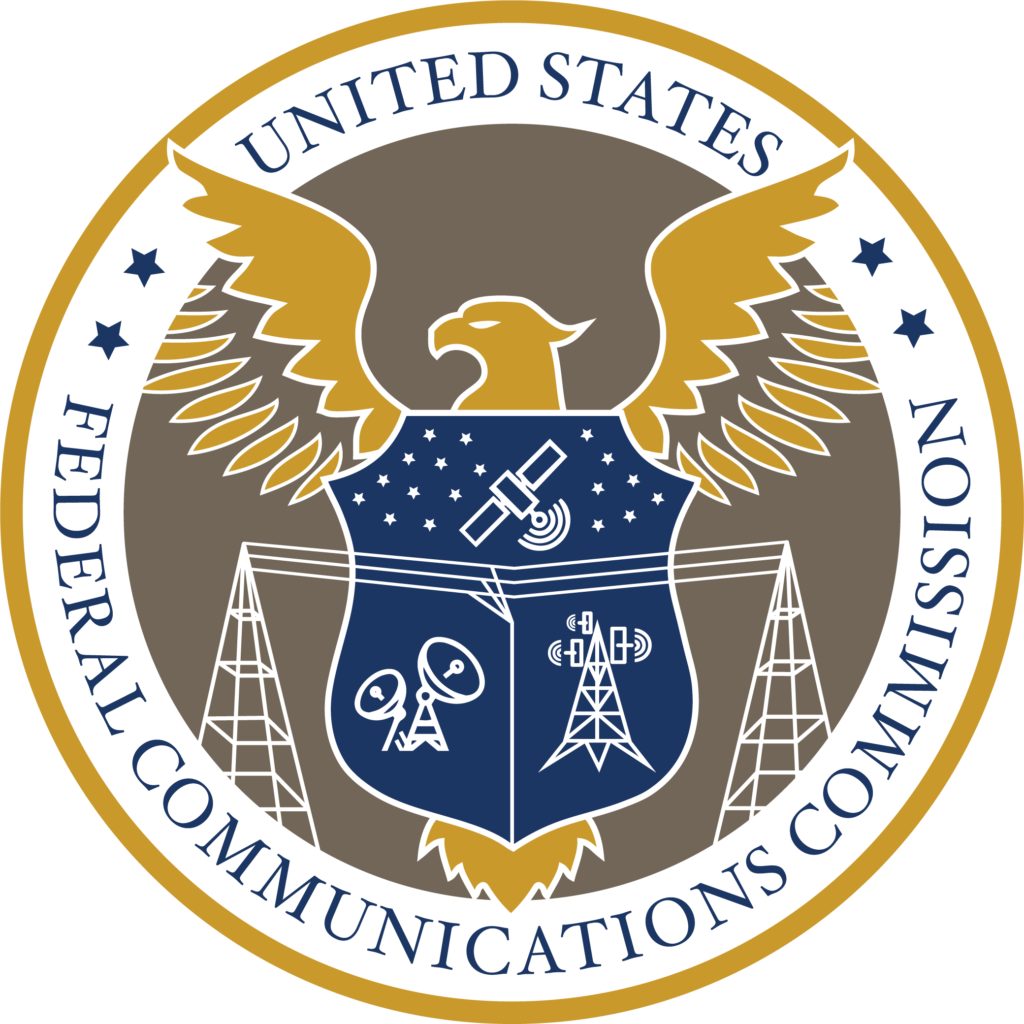
What is E-Rate?
The E-Rate program, formally known as the Schools and Libraries Program of the Universal Service Fund, is a federal initiative administered by the Universal Service Administrative Company (USAC) under the oversight of the Federal Communications Commission (FCC). It provides substantial discounts to assist schools and libraries in the United States in obtaining affordable telecommunications, internet access, and internal connections necessary for digital learning and information access.
Key Features of the E-Rate Program
- Discounts on Eligible Services:
- Telecommunications Services: Includes traditional phone services, VoIP, and other telecommunications.
- Internet Access: Funding for high-speed internet connections and related services.
- Internal Connections: Covers networking equipment like routers, switches, wireless access points, and cabling.
- Managed Internal Broadband Services (MIBS): Managed services for eligible internal connections.
- Basic Maintenance: Maintenance services to ensure the continued operation of eligible internal connections.
- Eligibility:
- K-12 public and private schools (excluding for-profit schools).
- Public libraries and many private libraries (excluding for-profit libraries).
- Discount Levels:
- Discounts range from 20% to 90%, determined by the level of economic need and the urban or rural status of the institution.
- The discount percentage is calculated based on the number of students eligible for the National School Lunch Program (NSLP).
- Application Process:
- Form 470: Initiates the competitive bidding process for the desired services.
- Form 471: Application for E-Rate discounts, listing the selected services and vendors.
- Form 472 (BEAR): Billed Entity Applicant Reimbursement form, used to request reimbursement after paying for services.
- Form 474 (SPI): Service Provider Invoice form, used by the service provider to request reimbursement.
- Funding Cycles:
- The E-Rate program operates on a funding year basis, typically running from July 1 to June 30.
- Program Integrity:
- The program includes measures to prevent waste, fraud, and abuse, such as competitive bidding requirements and detailed record-keeping.
Benefits of the E-Rate Program
- Cost Savings: Significantly reduces the cost of telecommunications and internet services for schools and libraries.
- Enhanced Connectivity: Supports the deployment of high-speed internet and advanced networking technologies, essential for digital learning and modern library services.
- Educational Advancement: Facilitates access to digital educational resources, online learning platforms, and collaboration tools.
- Equal Opportunities: Helps bridge the digital divide by ensuring that all students and library patrons, regardless of location or economic status, have access to modern technology.
How E-Rate Transforms Education and Libraries
The E-Rate program plays a crucial role in transforming education and library services across the United States. By providing financial support for essential connectivity, the program enables schools to integrate digital learning tools into their curricula and libraries to offer expanded digital services. This access to technology and information is critical for preparing students for the digital economy and ensuring that community members can access essential resources and services.
For more detailed information, you can visit the official E-Rate website.
CableMasters Welcomes New Employee!
Welcome to the team, Obi!
CableMasters provides a variety of Telecom and Security services for the EDUCATION, GOVERNMENT, ENTERPRISE, HEALTH CARE, FINANCIAL INSTITUTIONS & RETAIL Industries!
See list of services in the video below:
CableMasters completed some CLEAN work for a Los Angeles government institution.
You can click on the image to see us on LinkedIn!
